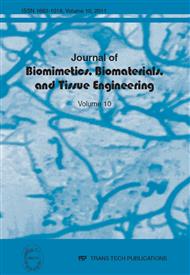p.7
p.17
p.25
p.43
p.55
p.67
p.75
p.81
p.95
Reinforcing of Porous Hydroxyapatite Ceramics with Hydroxyapatite Fibres for Enhanced Bone Tissue Engineering
Abstract:
Porous hydroxyapatite (HA) ceramic implants have attracted attention in bone tissue engineering due to their excellent bioactivity and biocompatibility due to their chemical similarity with the mineral component of natural bone. Unfortunately, HA when is formed into porous structures exhibits very low compression strength. In this study, fabrication of porous HA ceramic scaffolds containing HA fibers is presented. The primary aim of the study is to improve mechanical properties of the scaffold by introducing the fiber with uniform component relative to the scaffold. Scanning electron microscopy was used to observe the surface morphology and pore size of the scaffold. X-ray diffraction (XRD) was used to detect the phase composition and crystallinity of the scaffold. The compressive strength was determined using a universal material test machine. The results and the characterizations demonstrate the addition of HA fiber could enhance the uniformity of mechanical properties among samples and also the strength for a given open porosity.
Info:
Periodical:
Pages:
67-73
Citation:
Online since:
May 2011
Authors:
Price:
Сopyright:
© 2011 Trans Tech Publications Ltd. All Rights Reserved
Share:
Citation:


